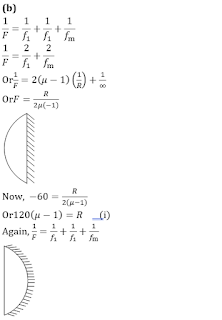RAY OPTICS AND OPTICAL INSTRUMENTS QUIZ - 18
Dear Readers,
JEE Advanced Physics Syllabus can be referred by the IIT aspirants to get a detailed list of all topics that are important in cracking the entrance examination. JEE Advanced syllabus for Physics has been designed in such a way that it offers very practical and application-based learning to further make it easier for students to understand every concept or topic by correlating it with day-to-day experiences. In comparison to the other two subjects, the syllabus of JEE Advanced for physics is developed in such a way so as to test the deep understanding and application of concepts..
Solution
(c)
Object is placed at a distance of 2f from the lens ( f = focal length of lens ), i.e., the image formed by the lens will be at a distance of 2f or 20 cm from the lens. So, if the concave mirror is placed in this position, the first image will be formed at its pole and it will reflect all the rays symmetrically to other side and the final image will coincide with the object
Object is placed at a distance of 2f from the lens ( f = focal length of lens ), i.e., the image formed by the lens will be at a distance of 2f or 20 cm from the lens. So, if the concave mirror is placed in this position, the first image will be formed at its pole and it will reflect all the rays symmetrically to other side and the final image will coincide with the object
Q3. A, B, and C are three optical media of respective critical angles C1, C2, and C3. Total internal reflection of light can occur from A and B, also from B to C but not from C to A. Then, the correct relation between the critical angles is
Q4. A person is looking at the image of his face in a mirror by holding it close to his face. The image is virtual. When he moves the mirror away from his face, the image is inverted. What type of mirror is he using?
Solution
(b)
Clearly, plane mirror and convex mirror cannot produce inverted image
(b)
Clearly, plane mirror and convex mirror cannot produce inverted image
Q6. A plano-convex lens when silvered on the plane side behaves like a concave mirror of focal length 60 cm. However, when silvered on the convex side, it behaves like a concave mirror of focal length 20 cm. Then, the refractive index of the lens is
Q7. For statement of question 118, if the heights of the two images are h1 and h2, respectively, then the height of the object (h) is
Q8. A convex mirror and a concave mirror of radius 10 cm each are placed 15 cm apart facing each other. An object is placed midway between them. If the reflection first takes place in the concave mirror and then in convex mirror, the position of the final image is
Q9. A convex mirror of radius of curvature 1.6 m has an object placed at a distance of 1 m from it. The image is formed at a distance of
Q10. The image of an object placed on the principal axis of a concave mirror of focal length 12 cm is formed at a point which is 10 cm more distance from the mirror than the object. The magnification of the image is

















